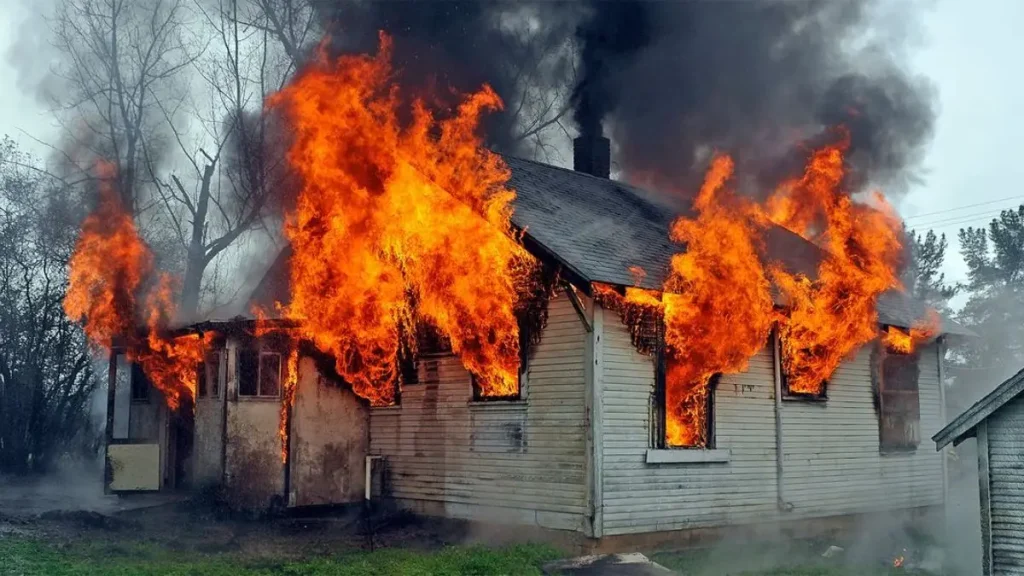Chimney Blaze Destroys Smith County Home
I remember reading about this fire and feeling a knot in my stomach—it’s always jarring when a home, a place full of memories, is suddenly gone. Early Tuesday morning, just before 8 a.m., a house on County Road 495, east of the Swan community in Smith County, was engulfed in flames. The fire started in the chimney, according to Fire Marshal Chad Hogue, and quickly spread into the attic, leaving the home completely destroyed.
When I think about the first responders arriving on the scene, I can’t help but admire their courage. A firefighter from Smith County ESD2 was hit by a falling ceiling during overhaul, prompting a mayday call. Thankfully, EMS evaluated him immediately, and he walked away without serious injuries. But the incident reminds me—and should remind all of us—how quickly a routine fire can turn dangerous, even for trained professionals.
The Fire Marshal confirmed the fire was accidental, emphasizing that even small oversights in chimney maintenance can have devastating consequences. For me, the takeaway is clear: prevention isn’t optional. A chimney might seem harmless, but without regular cleaning and inspection, it can become a ticking time bomb.
How Chimney Fires Can Spread and Become Dangerous?

You might think a chimney is harmless, just a small part of your home—but in reality, it can be one of the most dangerous hidden fire hazards. Chimney fires often start from creosote buildup, blocked flues, or overheating when wood burns too hot. In the Smith County incident, the fire began in the chimney and quickly spread into the attic, destroying the entire house.
What makes chimney fires so risky is how fast the heat travels. The flames can sneak through cracks or gaps, igniting insulation or wooden beams in the attic. I’ve seen this pattern in many cases: people underestimate a chimney fire because it starts small and quiet, but the attic becomes a tinderbox before anyone realizes it. That’s why experts recommend annual inspections and cleaning—you’re not just protecting your fireplace, you’re protecting your entire home.
Even more surprising is how common these fires are. The U.S. Fire Administration reports that hundreds of homes each year suffer major damage from chimney fires, often because homeowners skip preventive maintenance. If you want to keep your family safe, don’t wait until a spark becomes a disaster.
Firefighter Safety During the Smith County Response
Reading about the Smith County fire, I couldn’t help but think about the firefighters on scene. As per CBS19 TV, During the overhaul stage, one firefighter from Smith County ESD2 was struck by a falling ceiling, prompting a mayday call. EMS evaluated him immediately, and thankfully, there were no serious injuries.
These incidents are a stark reminder that even trained professionals face enormous risks. Firefighters must navigate unstable structures, hidden flames, and smoke-filled spaces.
For homeowners, this highlights why early detection and prevention are critical. The safer your home is, the safer everyone responding to it will be.
Fires can destroy lives in an instant, leaving families without a home, just like the Glastonbury fire that displaced an entire family.
Expert Recommendations for Homeowners
If there’s one thing I want you to take away from this, it’s that chimney maintenance can’t be ignored. Fire Marshal Chad Hogue said it clearly: “It is recommended to have your home’s chimney cleaned and inspected annually”.
But there’s more you can do. Make sure your fireplace is used correctly, never burn inappropriate materials, and always check for signs of soot buildup or unusual smoke. Smoke detectors near your attic and chimney aren’t optional—they’re lifesavers.
And if you live in Smith County or anywhere prone to chimney fires, consider hiring a certified chimney sweep. You’re not just following advice—you’re actively preventing a potential tragedy.
If you want to stay updated with fire safety tips, homeowner alerts, and quick prevention advice, you can join a free WhatsApp channel where real-time alerts and helpful tips are shared with homeowners.
Community and Regional Perspective

This fire isn’t just an isolated event. Chimney and attic fires are more common than most of us realize, and in rural areas like the Swan community, risks are amplified. Limited access to hydrants, long response times, and older homes can all make a fire more devastating.
I’ve noticed a gap in how local news covers these events: they report the incident but rarely dive into prevention for the wider community.
That’s where we can provide value. Sharing knowledge about safe chimney practices, fire alarms, and early detection measures can save lives—not just property. Communities that prioritize awareness and preparedness see far fewer tragedies.
Fires like the one in Smith County are sadly not uncommon. Similar tragedies have occurred elsewhere, such as a Massachusetts home fire that claimed lives and left a family devastated.
Lessons Learned and Next Steps
There’s a lot we can take away from the Smith County fire. First, prevention works. Regular chimney inspections, proper fireplace usage, and early detection can make the difference between a small incident and a total loss.
Second, insurance and rebuilding considerations are important—homeowners need to understand their policies and act quickly after a fire.
Finally, community support matters. Neighbors can help by checking on each other’s fire safety practices or supporting local firefighters with resources. For me, the biggest lesson is that fire prevention isn’t just personal—it’s a collective responsibility.
Reviewing past incidents can teach us valuable lessons. In Waukesha, a tragic house fire took the lives of a mother and daughter, reminding us how critical fire prevention and early detection truly are.
Quick Chimney Fire Prevention Checklist
I like to end with a practical checklist you can act on today:
- Schedule an annual chimney cleaning and inspection.
- Remove creosote buildup and ensure the flue is clear.
- Use your fireplace properly—avoid burning plastics or treated wood.
- Install smoke detectors near your attic and chimneys.
- Maintain a safe distance from flammable materials around your fireplace.
- Know your local emergency contacts, including Smith County Fire Marshal and certified chimney sweeps.
If you do even half of these, you’re drastically reducing the risk of a devastating fire like the one that destroyed the Smith County home.
Take Action Before It’s Too Late
I know it’s easy to think, “It won’t happen to me,” but the Smith County fire is a stark reminder that accidents can strike anyone.
Take a moment this week to check your chimney, schedule an inspection, and make sure your smoke detectors are working. These small steps could save your home—and more importantly, your family.
I’d love to hear from you: have you ever had a chimney inspection, or experienced a near-miss with a home fire? Share your story in the comments or reach out to your local fire department for guidance.
Talking about these experiences helps all of us stay safer—and it could prevent the next disaster before it starts.
For more real-life stories and safety tips from homeowners who’ve faced fire emergencies, check out our Home Incidents category. You’ll find lessons learned, prevention advice, and expert guidance all in one place.
Disclaimer: This article is for informational and educational purposes only. It does not replace professional fire safety advice or official guidance from local authorities. Always consult certified professionals for inspections, maintenance, or emergency situations.


